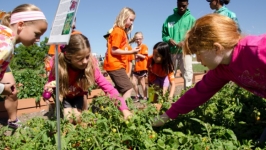Transforming America’s Food Culture, Now and Tomorrow
Farming isn’t what it used to be. Of course, not many things are—especially when you compare today’s America to that of Colonial days. Technology and a surging population have changed the way we live; commerce, across all sectors—agriculture included—has flourished and changed in unpredictable ways. But how can something so basic as the food we eat change?
A 1986 report by the Office of Technology Assessment of the U.S. Congress addressed our ever-changing food system, suggesting the number of farms in America was destined to decline by almost half in less than two decades: With 2.2 million farms in 1982, the OTA predicted that by 2000 there would likely be only 1.2 million. The prediction did not include an overall decrease in actual food production, but that who would be producing our food, and how, would change.
The report went on to address the consolidation and industrialization of farming along with a decline in midsized farms and agricultural exports as part of the reason and pointed to the need for more sustainable agriculture. But what the report didn’t address was the declining number of farmers willing and able to farm.
The aging American farmer
In the early 1800s, the newly independent United States relied heavily on agriculture with over 80 percent of the population directly involved in farming. By midcentury, however, the farming sector fell drastically behind other emerging industries—manufacturing, transportation, services—to roughly 50 percent. Today, a mere two percent of the U.S. population is comprised of farm and ranch families.
“My family’s been in the farming business since the 1600s,” says Todd Jameson of Balanced Harvest Farm, an organic-style Certified Naturally Grown family-operated vegetable and herb garden southeast of Indianapolis.
“I’m 57 years old, and my farm will die with me,” he said. “No one will carry on the tradition.”
Jameson isn’t alone. The U.S. Department of Labor puts the average age of farmers and ranchers at 58 with nearly one third of principal farm operators aged 65 or older. In fact, over the course of the last three decades, the average age of U.S. farmers has increased by close to eight years, from 50.5 to 58.3—not simply because they’re getting older, but because fewer among younger generations are choosing farming as their lifelong occupation.
“An urban-scale operation doesn’t generate enough revenue to sustain a lifestyle,” said Jameson, adding there’s a crucial need for more programs designed to train people to farm the small to midsize operations.
“Small-scale diversified farmers are growing dozens of crops simultaneously,” said Emily Toner, the urban agriculture educator with Purdue Extension Marion County.
“They are incredibly productive, both in terms of crop output and economic output, but most of them are figuring out how to do it through trial and error. More research and support for this type of production is needed.”
But here in Indiana, interest in small-scale and organic farming is skyrocketing.
“New farmers markets and chef-driven farm-to-table restaurants are popping up all over the place and they are all looking for quality, locally grown food,” says Genesis McKiernan-Allen of Full Hand Farm in Noblesville and co-leader of the Hoosier Young Farmer Coalition.
“Consumer education about the dangers and risks of synthetic pesticides and the overuse of antibiotics is growing and people are looking for healthier, cleaner alternatives in their food choices,” he said. “Small-scale organic farmers in our state are poised to meet those demands, there just aren’t quite enough of us to fully meet the demand.”
What is a small-sized farm or a small-scale operation? The answer, as it turns out, depends on a number of factors including what’s being produced: what kind of crop or livestock; what’s needed for proper production of the product; and varying market values. The USDA identifies farms not by size but by sales class and homogenous groups such as family farms, or farms organized as proprietorships, partnerships and family corporations that are not operated by a hired manager, as well as non-family farms. In layman’s terms, farms are classified by economic viability and land size: operations grossing $350,000 or less are typically considered small as are those with less than 961 acres.
Here in Indiana, the average farm is 245 acres. Across the U.S., the average farm is 441 acres and 88 percent of all farms are considered small, but it’s the other 12 percent that make up roughly 80 percent of all agriculture sales—sales that are down everywhere in the U.S. except here in the Heartland, and the neighboring Mississippi Portal and Prairie Gateway regions.
Millennials and the next generation of farmers
Though it’s true that the average American farmer is older than in the past, the good news is those operating certified organic farms are younger and the Millennial generation is poised to get their hands dirty.
“Most of the young farmers I know want real, tangible work where results are palpable,” says Nate Brownlee, co-leader of the Hoosier Young Farmer Coalition and owner, along with wife, Liz, of Nightfall Farm in Crothersville.
“We want to get our hands dirty, grow food and feed our community,” he said. “A lot of young farmers have had a taste of good food, and we want to be involved in growing and raising our food.”
“Our generation,” Liz said, “is very tuned in to the fact that we have to take better care of our communities and our planet. Many Millennials vote with their forks, and choose to buy food directly from farmers and eat at restaurants that serve genuinely local food. Millennials are also a large part of the growing back-to-the-land movement. Those that grew up in urban areas are working to try and begin farming their own food and food for markets and wholesale.”
But although the drive and apparent call-to-action exists in the younger generation, farming isn’t easy and the lifestyle isn’t always the most attractive.
“Farming is capital intensive and risky, and there are fewer state and federal resources available to organic growers than conventional,” said McKiernan-Allen.
“Getting started farming, or even transitioning to organic, is a long, hard process, but one that many people want to undertake. The Hoosier Young Farmer Coalition was started in recognition of the myriad of challenges facing farmers, especially young and beginning farmers. We hope to capitalize on the growing demand for good food in our state by organizing and supporting growers in their first years of production, helping to ensure their success,” he said.
Likewise, Jim Riddle—chairman of Minnesota’s Organic Standards Board and former chairman of the USDA National Organic Standards Board—believes getting younger generations interested in farming critical to American’s agriculture future.
“Farms are dying,” he said. “They can’t keep up with the labor … there’s risk and it takes a lot of dedication and hard work … there’re few vacations and finding capital to be able to farm is increasingly difficult.” But, he said, the organic movement is carrying a positive message and it gives him hope to see young people getting involved.
“I’ve been to organic conferences throughout the country where child care is provided and organizers seem to be on track with helping young farmers succeed. There’s enthusiasm and optimism.”
Conquering the food desert
Another issue is the growing number of food deserts across the country. In the U.S., more than 23 million people, of which close to half are low-income, live in areas significantly lacking fresh produce and other healthy options. And since a diet void of healthy foods can lead to diabetes, heart disease and obesity, many experts agree that a key component to a healthier America lies in conquering the food deserts.
Walk Score, a private company publishing a public access walkability index to any address in the U.S., Canada or Australia, looked at cities with a population over 500,000 and scored them based on how many people could walk to a grocery store within five minutes. In New York City, 72 percent of residents can travel to some kind of grocery store in five minutes or less. In Indianapolis, only five percent of residents have the ability to do so, making the city one of the largest food deserts in the country.
But, in partnership with the USDA, researchers at the University of Pennsylvania, recently found that proximity to healthier eating choices and the ready supply of fresh foods does not impact food-consumption patterns as much as the lack of education and poverty level that coexist within food deserts.
“We need education and support on a community level to change people and neighborhoods,” says Chef Craig Baker Owner of The Local, Bent Rail and formerly Plow and Anchor, eateries located in Indianapolis. “The American diet needs to develop a palate heavier in vegetables and less dependent on cheap, subsidized meat.”
One way to encourage Americans to eat healthier foods, suggests Baker, is to promote and therefore purchase products from farms that raise their animals in a humane and organic way. And though it’s true, he says, that farmers can’t raise as many animals and the final product costs more, in the end it’s healthier, more environmentally friendly and tastes better.
Riddle, the former chairman of the National Organic Standards Board, agrees. “We need to transform the way we eat,” he said, and he thinks training children to eat better plays a big role. Fast food, he said, comes with toys; it’s marketed to kids, but it’s the adult that buys the meal.
“We need to concentrate on improving our health … wake up … remember I am what I ate, I am what I eat.” Most importantly, he advises everyone plant a garden.
“Get in touch with the earth,” he said. “Develop a gentle relationship with the earth and know where your food comes from. Know what’s in it and how it was grown … go for a walk … get outside … put the device down and reconnect.”
The rise of the organic farmer
A longtime supporter of Hoosier agriculture, the Indiana State Fair dubbed 2015 the “Year of the Farmer.” Duly appropriate as over 80 percent of Indiana land comprises farms and forests, but what about the organic farmer? Could his and her year be coming soon?
Throughout the U.S., the number of certified organic farms increased by 12 percent from 2014 to 2015. Here in Indiana, with the addition of 81 certified organic operations during that time, we saw an even higher increase of 17 percent.
“The average age of the organic farmer is 53,” said Riddle—which isn’t a drastic difference from the non-organic farmer’s average age of 58, but it’s something. But unfortunately, said Riddle, here in the U.S. we don’t have any real strategy to help conventional farmers convert to organic. Riddle suggests looking to the European market, where organic farming is not only the wave of the future, but that of the present: Denmark is committed to becoming 100 percent organic by the year 2020; in Italy, school lunches must be 100 percent organic by law; in Switzerland 13 percent of all farmland is certified organic; in Croatia certified organic farmland increased by over 375 percent from 2010 to 2015; and in Germany, the demand for organic produce is so high farmers are having a tough time keeping up.
Over all, agriculture land designated “organic” in Europe is nearing seven percent; here in the States, we haven’t even hit one percent yet. But we are headed in the right direction.
“Industry studies show there’s a huge demand for non-GMO products,” Riddle said, “but there’s more to it than that.” Consumers, he said, need to understand the labeling system.
“Certified organic products are non-GMO and the word "natural" on its own doesn’t mean the same thing.”
In fact, laws regulating the use of the word “natural” when it comes to food labeling are lenient, at best. And although under the USDA’s definition, foods labeled as natural cannot contain artificial ingredients, they can contain growth hormones, antibiotics and other chemicals.
It’s important to note, however, that Certified Naturally Grown is different. CNG is a grassroots alternative to the USDA’s National Certified Organic program in which farmers essentially inspect one another’s practices. CNG has less paperwork and typically costs less than NCO, making it an attractive alternative for small-scale farms that produce by organic standards but can’t necessarily afford to keep up with the certification process.
As for the future of agriculture in America and the future of our farmers, organic or traditional, there are still too many unknowns to make any kind of accurate prediction as to how our food culture will evolve over the next year, let alone the next decade or century. But, for the farmers’ sake, and for our own, let’s hope America continues to move in the direction that supports local and regional farm sales within our communities and, in doing so, encourages sustainable farming. And who knows, maybe in 2018, when the Farmers’ Almanac celebrates its 200th edition by recognizing America’s outstanding farmers and ranchers, maybe, just maybe, one of the honorees will be the guy—or the gal—who lives down the street.
Why buy local?
An important, if not critical, component to a healthier, more sustainable agriculture system, lies in educating consumers to buy locally sourced food. But first, people need to understand what the word “local” really means and why there’s so much hype associated with the word.
In a nutshell, local and regional foods are those located within a well-defined area and having all of the activities related to producing, processing, distributing and marketing also contained within the specified region. But geography is only part of the equation. Locally based food systems take it a step further than simply feeding us; they also provide much-needed information to the consumer about the foods they’re choosing to buy, where it comes from and who produced it. In theory, this knowledge helps people steer their purchases to directly benefit the local economy.
“Ultimately,” said Todd Jameson of Balanced Harvest Farm, “the consumer holds the key. Every time they spend a $1 on food, they’re either voting for an industrialized food system where there’s always more available, or their voting for the local guys.” And, he says, farmers are well known for reinvesting their dollars within their communities.
Throughout the country, though diverse in many ways, the common desire to see our communities prosper is everywhere and it’s becoming clear the money we spend on food is increasingly becoming an influential tool for local investment. In response to this growing demand for local and regional foods, in 2009 the USDA launched its Know Your Farmer, Know Your Food initiative. The program provides grants, loans and other resources designed to help farmers and ranchers and food businesses find new opportunities within the expanding local and regional food sector.
As for the hype surrounding the buy local message, it’s really pretty basic: Buying locally produced goods, be it food or otherwise, is a win-win both for the consumer and the merchant. And that’s something we can all strive to do a little bit better.









